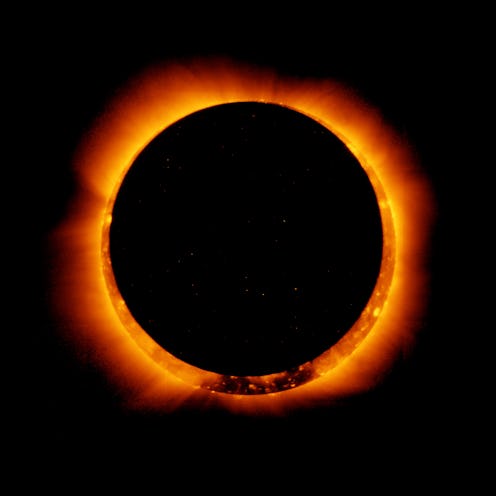A lot is happening on Sept, 1: A new month, a new season, a new apartment (for me and also seemingly half the city of Chicago) — oh, and, um, at some point the sun may look like a giant floating ring in the sky and the world may feel like it's ending. Because the annular solar eclipse is happening on Sept. 1, 2016, as well — and it's probably the event that I'm most excited about. Not because of the world feeling like it's ending (which is probably not going to happen), but because annular solar eclipses are really, really cool.
A solar eclipse, generally speaking, occurs when the moon moves between the Sun and the Earth, but there are actually four different kinds of solar eclipses: Total, partial, annular, and hybrid. Next Thursday, we'll be witnessing an annular eclipse, which can only happen when the moon is at apogee. You know "supermoons?" Well, there are also "mini moons," which occur when the moon is at its peak distance away from the earth. Though at the eclipse's peak on Sept. 1 the moon will fully cover the sun, the moon will have a smaller diameter; hence, the "giant floating ring" effect.
Here's the potentially bummer news: Obviously, the entire world doesn't collectively get to witness a solar eclipse. According to NASA, both the "Greatest Eclipse" and "Greatest Duration" locations this time around are located in Tanzania.
Which is great news if you live in Tanzania, specially southern Tanzania near the border of Mozambique! Because for a maximum of three minutes and five seconds, you'll get to witness this truly incredible natural event with the ability to remind us that we are very small and the world is very large and mysterious! However, it's not great news if you live in, say, the United States, because you probably won't be able to see it live. However, you'll likely be able to catch it on a livestream, so at least there's that; furthermore, you can track its path on NASA's website. Isn't the internet wonderful?
The initial phase of the eclipse will begin around 3:14 p.m. EST, with the actual annular part hitting its peak at 5:05 p.m. EST. So while you may not be able to witness this event, you can certainly acknowledge that it's happening, and that across the world, they're looking at a completely different sky. And that's still pretty cool.
Images: Giphy
